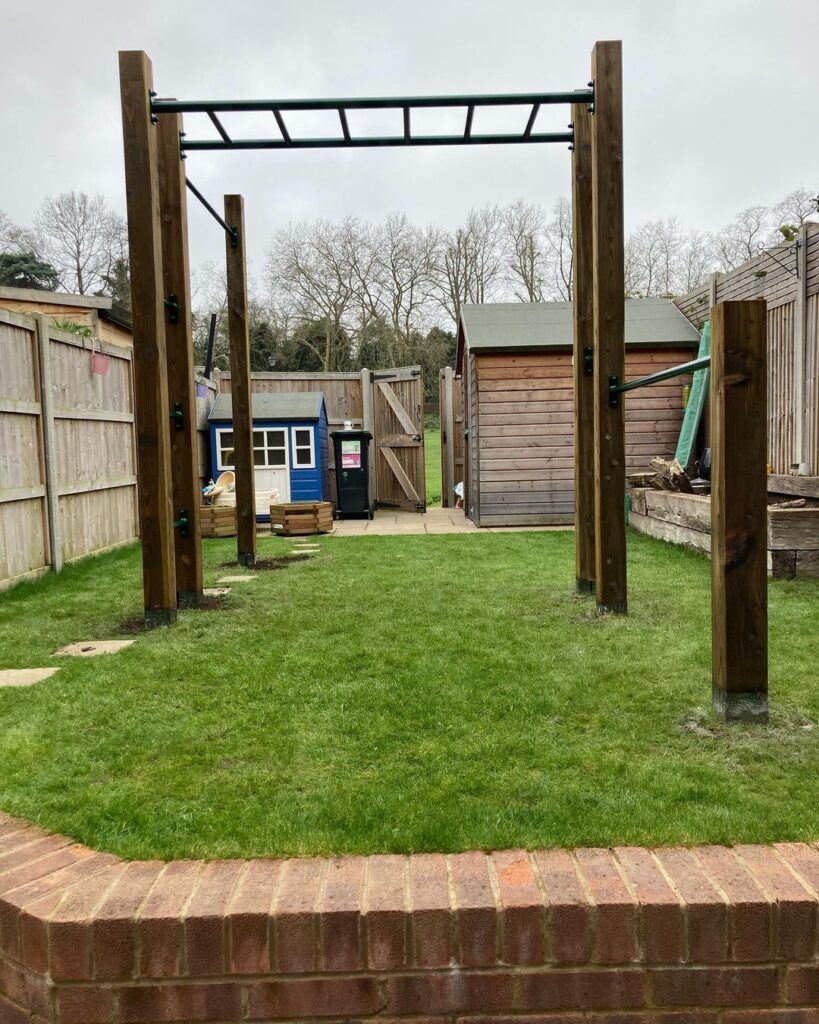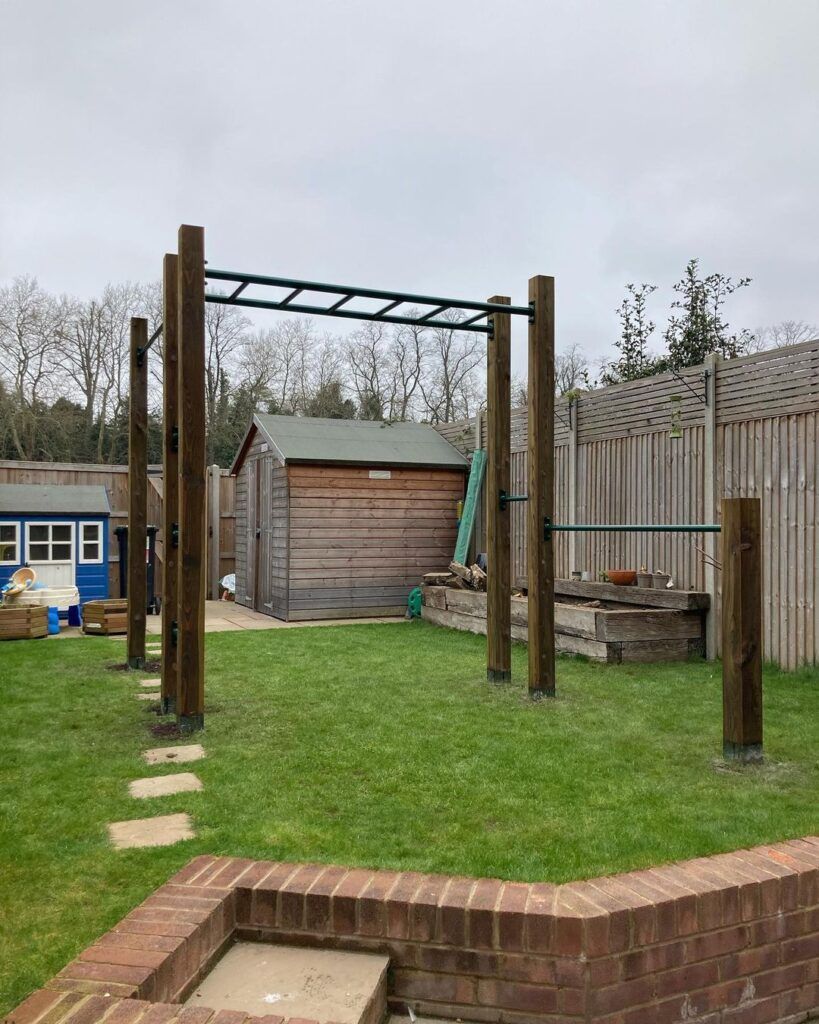Which muscles do monkey bars work?
Monkey bars are a great exercise for building upper body strength, particularly in the arms, shoulders, chest, and back muscles. When you perform monkey bars, you engage various muscle groups, including:
- Latissimus dorsi: These are the largest muscles in your back, located on each side of the spine. They help you pull your body weight up and across the monkey bars.
- Biceps: These muscles are located in the front of your upper arm, and they help you bend your elbow and lift your body weight.
- Forearms: The muscles in your forearms help you grip the bars and control your movements.
- Shoulders: Your shoulder muscles, including the deltoids and rotator cuff muscles, help you stabilize and move your arms while performing monkey bars.
- Chest: The pectoral muscles in your chest also help you lift and move your body weight across the monkey bars.
Overall, monkey bars provide an effective upper body workout that targets multiple muscle groups simultaneously.

What age can a child do monkey bars?
The ability to do monkey bars can vary depending on the child’s physical development and coordination. Most children will develop the necessary strength and coordination to use monkey bars by the age of 5 or 6 years old. However, some children may be able to use monkey bars as early as 3 or 4 years old, while others may not be able to do so until they are 7 or 8 years old.
It’s important to note that children should always be supervised when using playground equipment, including monkey bars. They should also be encouraged to use proper form and technique to avoid injury. If you’re unsure whether your child is ready to use monkey bars, you can consult with a pediatrician or physical therapist to determine if they have the necessary strength and coordination.

Why are monkey bars harder for adults?
Monkey bars may be harder for adults than for children for a few reasons:
- Decreased upper body strength: As we age, our muscle mass tends to decrease, and we may lose some of our upper body strength. This can make it more challenging to pull our body weight across the monkey bars.
- Reduced flexibility: Adults may have reduced flexibility in their shoulders and back, making it harder to perform the required movements to swing from bar to bar.
- Fear of falling: Adults may be more risk-averse and have a greater fear of falling, which can make them more hesitant to use monkey bars.
- Lack of practice: Children tend to play on monkey bars more frequently than adults do, which means they may have developed more strength, coordination, and confidence over time.
It’s worth noting that some adults may still be able to use monkey bars with ease, particularly those who have maintained their strength and flexibility through regular exercise. However, for many adults, monkey bars may pose a greater challenge than they did during childhood.

How long should you hang on monkey bars?
The amount of time you should hang on monkey bars depends on your fitness level and goals. If you are just starting out, you may want to begin with short hanging intervals and gradually increase the time as you build strength. A good starting point for beginners might be to hang for 10-15 seconds at a time.
For more advanced exercisers, hanging on monkey bars can be used as a form of isometric training, which involves holding a static position to build strength. In this case, you may want to aim for longer hanging intervals of 30 seconds or more.
It’s important to listen to your body and avoid overdoing it when working out on monkey bars. If you feel any discomfort or pain in your shoulders, back, or arms, it’s best to stop hanging and rest for a while. You can also consult with a fitness professional to determine the best hanging time and technique based on your fitness level and goals.

Why can’t some children do monkey bars?
There are several reasons why some children may have difficulty doing monkey bars:
- Lack of upper body strength: Monkey bars require a lot of upper body strength, and some children may not yet have developed the strength needed to pull themselves up and swing from bar to bar.
- Poor grip strength: Children with weak grip strength may have difficulty holding onto the bars, which can make it challenging to move across the monkey bars.
- Poor coordination: Coordinating the movements required for monkey bars can be challenging for some children, particularly if they have not yet developed good motor skills.
- Fear of falling: Some children may be afraid of falling while using monkey bars, which can make them hesitant to try.
- Physical disabilities: Children with certain physical disabilities, such as cerebral palsy or muscular dystrophy, may not have the strength or coordination required to use monkey bars.
It’s important to note that every child develops at their own pace, and some may take longer to develop the strength and coordination needed for monkey bars. If your child is having difficulty with monkey bars, you can encourage them to keep trying, but it’s also important to be supportive and help them find other forms of physical activity that they enjoy and feel comfortable with.

How to do monkey bars for beginners!
If you’re a beginner, the following steps can help you learn how to do monkey bars:
- Start with a low bar: Look for a set of monkey bars where the first bar is low to the ground, so you can practice hanging and swinging without falling from a high distance.
- Hang from the first bar: Grasp the first bar with both hands, keeping your arms straight and your feet off the ground. Try to hang for a few seconds at a time, focusing on maintaining a tight grip and engaging your core muscles.
- Move to the next bar: Once you feel comfortable hanging from the first bar, swing your body forward to grab the second bar. Keep your arms straight as you swing, and try to land your feet on the ground when you let go of the first bar.
- Practice swinging: Once you can move from bar to bar with your feet on the ground, start practicing swinging from one bar to the next without touching the ground. Use your momentum to swing forward and backward, keeping your body in a straight line and engaging your core muscles.
- Build up your strength: To improve your strength for monkey bars, you can also try doing pull-ups, push-ups, and other upper body exercises.
Remember to always practice safety when using monkey bars. Make sure the bars are secure and stable, and avoid using them in wet or slippery conditions. It’s also a good idea to have a spotter or to use safety mats to prevent injury in case of a fall.

Are monkey bars better than pull ups?
Monkey bars and pull-ups are both effective upper body exercises, but they target slightly different muscle groups.
Pull-ups primarily work your back, shoulders, and biceps, while monkey bars engage these muscles as well as your forearms, grip, and core. Monkey bars also provide an additional challenge by requiring you to move from bar to bar, which can help improve your coordination and overall body control.
Which exercise is “better” really depends on your fitness goals and personal preferences. If you’re looking to build upper body strength and specifically target your back and biceps, pull-ups may be a more focused exercise for you. However, if you’re looking for a full-body workout that challenges your grip strength and coordination, monkey bars may be a better option.
It’s also worth noting that both exercises can be scaled to suit your fitness level. For example, if you’re just starting out, you may want to begin with assisted pull-ups or hanging on monkey bars for short intervals, and gradually work up to more challenging variations as you build strength and confidence.

How to do monkey bars without hurting your hands
Hanging and swinging on monkey bars can be tough on your hands, particularly if you’re new to the exercise or haven’t built up calluses yet. Here are some tips to help you avoid hurting your hands while doing monkey bars:
- Use a grip aid: Wearing gloves, using chalk, or applying grip spray can all help improve your grip and reduce friction between your hands and the bars.
- Build up your grip strength: The stronger your grip, the easier it will be to hold onto the bars without causing discomfort. You can build grip strength by doing exercises like grip strengtheners, farmer’s walks, and hanging from a bar for increasing intervals of time.
- Use proper technique: Avoid gripping the bars too tightly or clenching your hands into a fist, which can strain your muscles and make it harder to hold on. Instead, try to keep your hands relaxed and open, with your fingers spread apart and your thumbs wrapped around the bar.
- Take breaks as needed: If your hands start to feel sore or tired, take a break and stretch your fingers and wrists. You can also switch to a different exercise for a few minutes before returning to the monkey bars.
- Gradually increase your time on the bars: If you’re new to monkey bars or haven’t done them in a while, start with short intervals of hanging and swinging, and gradually increase the amount of time you spend on the bars as your hands become more accustomed to the exercise.



